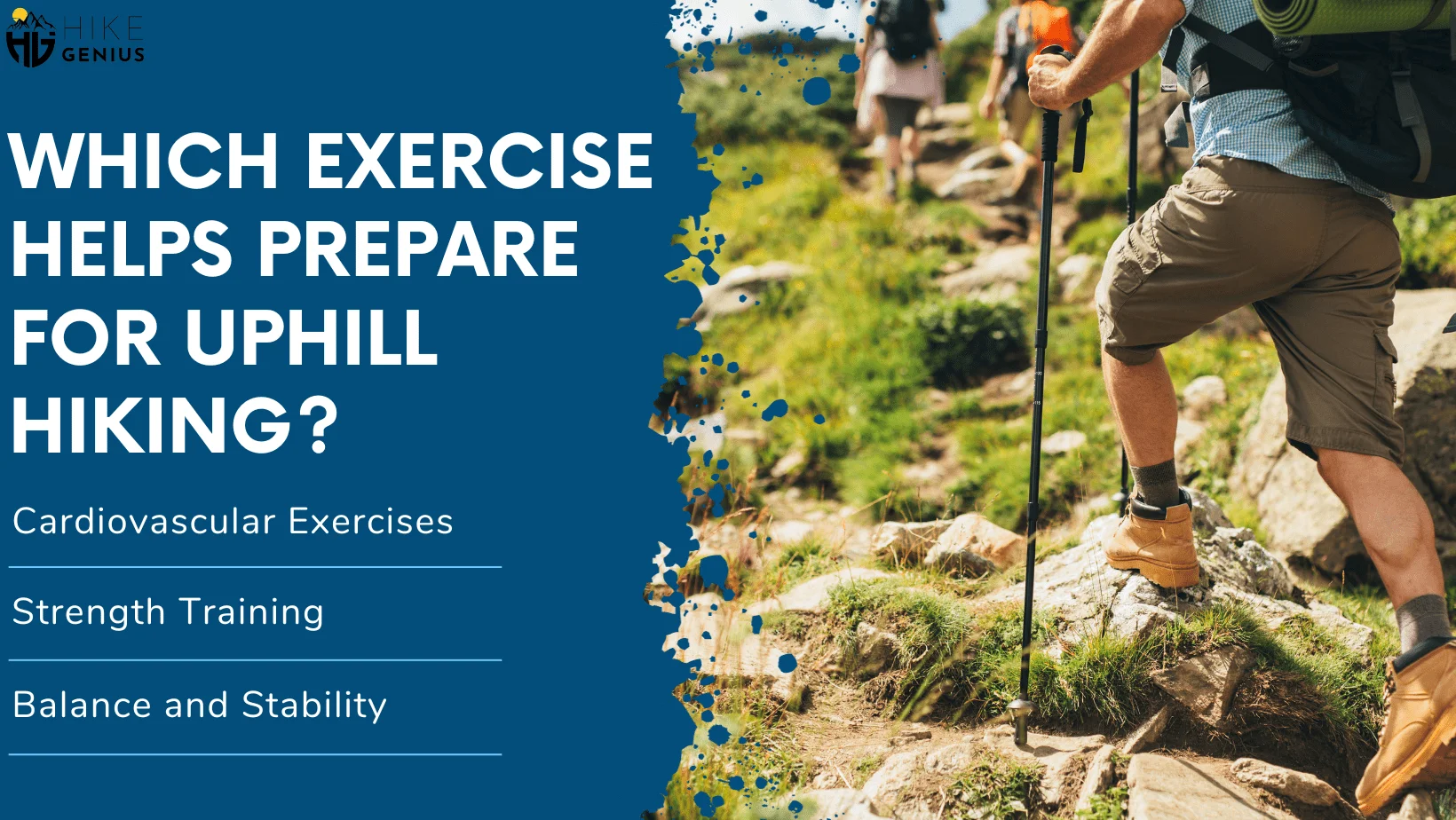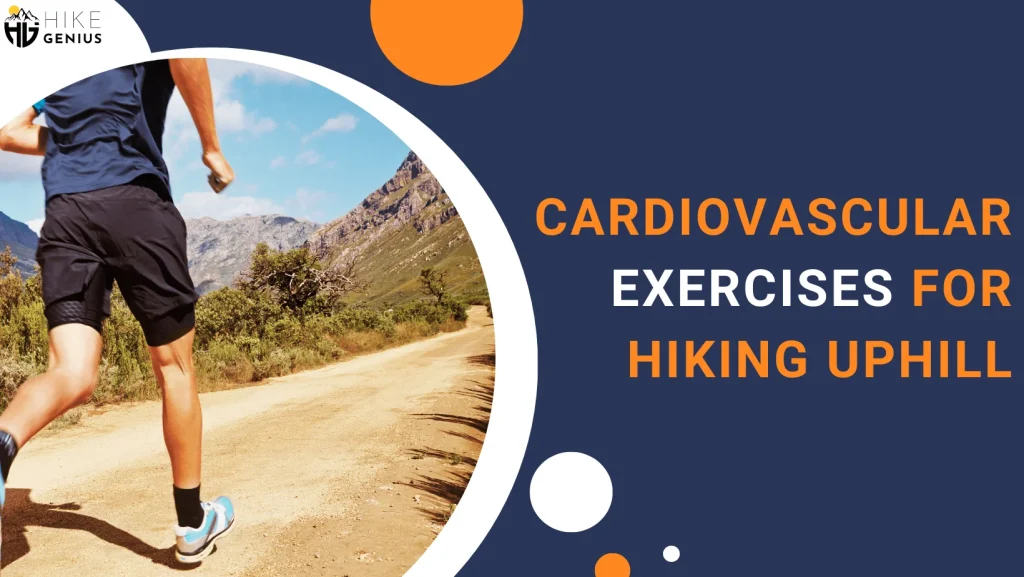Which Exercise Helps Prepare for Uphill Hiking?

We’ll talk about the value of physical fitness for hiking in this article and talk about the exercise which helps you prepare for uphill hiking.
If you enjoy a backpacking trip, you already know it’s a fantastic way to stay in shape, discover nature, and test your limits. However, being physically fit and well-prepared is essential to fully enjoy the experience and prevent injuries.
By the end of this article, the ideal exercises for steep hiking, how to incorporate them into your training program, and advice on gradually increasing their intensity will all be clear to you.
So that you can create a well-rounded fitness routine for hiking, we’ll cover various exercise types, including cardiovascular, strength training, and balance and stability exercises.
So let’s investigate the best workouts to get you ready for hiking uphill!
Which Exercise Helps Prepare For Uphill Hiking?
Although it can be difficult and rewarding, hiking uphill requires physical fitness and planning. This will examine the top workouts for getting ready for uphill hiking and their unique advantages.
Cardiovascular Exercises for Hiking Uphill

Interval Training: It entails alternating periods of intense exercise with periods of less intense recovery. For instance, you might sprint for 30 seconds, followed by a minute of walking or jogging, and then repeat the exercise for 20 to 30 minutes.
Incline Treadmill Walking or Running: Another great way to get ready for an uphill hike is to use an inclined treadmill to walk uphill. To simulate an uphill terrain, gradually raise the treadmill’s incline setting. You can do this to develop the stamina and leg strength necessary for uphill hiking.
Stair Climbing: Building lower and upper body strength and endurance through stair climbing is a great exercise. You can repeatedly ascend and descend the stairs, progressively picking up the pace and intensity. You can also use a stair climber machine if you lack access to stairs.
Strength Training Exercises for Steep Hiking

Lunges: Lunges are a great exercise for enhancing the stamina and core strength of the lower body that helps you prepare for uphill hiking. Step forward with one foot and lower yourself until both knees are bent at a 90-degree angle to perform a lunge. Repeat with the other leg after pushing yourself back up. Lunges can be executed using or without weights.
Squats: Squats are yet another excellent lower-body strength and endurance exercise. Standing with your feet shoulder-width apart, lower your body until your thighs are parallel to the ground to perform a squat. Push yourself back up to the starting position and then do it again.
Step-ups: Step-ups are good exercise for strengthening the lower body, especially the glutes, and hamstrings. Step onto a bench or concrete step with one foot and push up until your leg is straight to perform a step-up. After that, get back in the starting position and repeat with your other leg.
Calf Raises: Calf raises are quick exercises that develop the calf muscles’ strength. Standing with your feet shoulder-width apart, raise yourself onto your toes to perform a calf raise. Repeat by descending once more.
Balance and Stability Exercises

Exercises for Single-Leg Balance: Single-leg balance exercises are important for enhancing stability and balance, which are essential for hiking uphill. Spend 30 to 60 seconds standing on one foot and maintaining the posture. After that, repeat with the other foot.
Yoga Asanas: Warrior III, Tree Pose, and Eagle Pose can help increase lower body strength, stability, and balance. In Warrior III, one foot must be balanced while the other leg and torso are extended parallel to the ground. One foot must be balanced in the tree pose while the other rests on the inner thigh. Wrapping one leg around the other while standing on one foot is the Eagle Pose.
Tips For Incorporating Exercises Into Your Hiking Preparation Routine
In this section, we’ll review some suggestions for including exercises in your routine for getting ready for a hike.
Suggested Frequency of Hiking Exercise Sessions

Aim for 150 minutes or more of moderate-intensity exercise spread over three to five days weekly. Exercises that fall under this category could be aerobic ones like running or cycling, strength-training ones like lunges and squats, and poses from yoga that improve balance and stability.
But paying attention to your body and modifying the frequency and length of your workouts following your fitness level and objectives is crucial.
How to Gradually Increase the Intensity of Your Hiking Exercise Routine

Your exercise regimen must gradually increase in intensity and duration if you want to build endurance and prevent injury. For instance, you could begin with short walks or hikes and gradually increase the distance and intensity.
You can also train for hiking by incorporating interval training into your daily routine by alternating high-intensity exercises with low-intensity recovery periods.
Importance of Proper Form and Technique

Using the right form and technique will help you avoid injuries and get the most out of your workouts. For instance, when performing lunges, avoid leaning forward and keep your knee in line with your ankle. Avoid overstriding when running, and land in the middle of your foot.
To avoid muscle stiffness and soreness, it’s also crucial to warm up before exercise and stretch afterward.
Dynamic stretches, such as leg swings or lunges, can be incorporated into your warm-up, and static stretches, such as hamstring stretches, can be incorporated into your cool-down.
Tips For Steep Hiking For Beginners And Experts

Although hiking is a fantastic way to stay active and connect with nature, it can be difficult, particularly on uphill terrain. It’s crucial to mentally and physically prepare yourself if you’re new to hiking. To assist you in beginning your hiking journey, we’ll provide some beginner-friendly uphill hiking tips.
Choosing the Right Trail
Look for trails designated as easy or moderately difficult, and before you go, find out how far and how much elevation the trail gains. You can also seek advice from neighborhood hiking clubs or trail guides to find the best trail for you.
Essential Gear for Uphill Hiking
Invest in a good pair of traction – and ankle – supporting hiking boots, trekking poles, wicking clothing, and a backpack that can hold lots of water and snacks. It’s also crucial to bring a hat, sunglasses, and sunscreen for sun protection.
Related Blogs
How to Attach Hiking Sticks with Backpack?
How Tall Should Trekking Poles Be?
Preparing for the Hike
It takes strength and endurance to hike uphill. Start conditioning your body with cardiovascular exercises like walking, jogging, or cycling before you hit the trail. You can also include exercises like lunges and squats to develop leg muscles. To develop endurance, gradually increase your hikes’ length and elevation gain.
Hiking Techniques for Uphill Terrain
Keep your shoulders back, your head up, and your posture straight. Breathe deeply, using your nose to inhale and your mouth to exhale. To keep a steady pace, take smaller steps and stop as often as necessary to rest and drink water.
Safety Considerations
When hiking, put safety first. Before you hike, check the weather forecast, and stay out of the worst weather. Maintain marked trails and stay away from potentially hazardous shortcuts. Let someone know your hiking plans, and bring a map or GPS device. Bring a first aid kit and a whistle to call for assistance in an emergency.
Benefits Of Exercise For Uphill Hiking

Regular exercise is one of the best ways to prepare for this activity. In this section, we’ll talk about the advantages of exercise for uphill hiking, including how it can enhance your balance, muscular strength, and cardiovascular endurance.
Cardiovascular Endurance For Upward Hiking
You may hike up a steep incline without getting out of breath by exercising cardiovascular exercises, such as running, cycling, or swimming. You can hike farther and more effectively thanks to the increased body’s capacity to deliver oxygen and nutrients to your major muscles.
Core Muscles Strength For Leg Strength
It can be difficult to hike uphill, especially if you’re wearing a backpack. Regular exercises like weightlifting exercises can improve your muscular strength and endurance. You can improve your overall metabolic rate and increase your daily caloric expenditure by exercising, which will also help you maintain and build lean muscle mass.
Related Blog
Balance
It frequently takes a lot of stability and balance to hike uphill, especially on unsteady ground. Enhancing your proprioception and strengthening your core muscles through regular exercise can improve your balance (the sense of where your body is in space). Exercises like yoga, Pilates, or balance training can be especially beneficial in enhancing your stability and balance, making it simpler to negotiate difficult terrain.
Conclusion
We talked about the exercise that helps everyone prepare for Uphill Hiking. By incorporating cardiovascular exercises, strength training exercises at your local gym, and balance and stability exercises into your routine, you can build endurance, strengthen your leg muscles, and improve your overall control on uneven terrain.
Other than exercises, you will also need some reliable gears like trekking poles, hiking boots, warm clothing etc. Remember to gradually increase the intensity and duration of your exercise routine, maintain proper form and technique, and stay hydrated during your hikes. With these tips and a consistent exercise routine, you can confidently tackle any uphill trail with ease. Happy hiking!
Frequently Asked Questions
What Is the Best Training for Steep Hiking?
The best training for steep hiking includes a combination of cardiovascular exercises to build endurance, training exercises to build leg muscles, and balance and stability exercises to improve overall balance and control on uneven terrain. Gradual increases in distance and elevation gain, as well as proper gear and technique, are also important to train for hiking uphill.
What Muscles Need to Be Strong for Steep Hiking?
Steep hiking requires the use of several lower body muscle groups, including the quadriceps, hamstrings, glutes, and calves. These muscles are responsible for generating the power needed to ascend steep terrain, as well as providing stability and balance on uneven ground.
What Is the Breathing Technique for Steep Hiking?
When hiking uphill, it’s important to use a breathing technique that maximizes oxygen intake and minimizes fatigue. A common technique is to inhale deeply through the nose and exhale fully through the mouth, with a focus on breathing from the diaphragm rather than shallow chest breathing.
Additionally, taking shorter, more frequent breaths can help to regulate breathing and maintain a steady pace while hiking uphill. It’s also important to take breaks and rest as needed to avoid overexertion and maintain proper breathing.
How Can I Increase My Uphill Hiking Speed?
To increase your uphill hiking speed, you can improve your cardio endurance by incorporating cardio exercises like running, cycling, or stair climbing into your routine. Focus on building strength in your lower body with exercises like squats, lunges, and calf raises. Use proper breathing techniques and take shorter, more frequent steps to maintain a steady pace while hiking uphill.
Why Is Hiking Uphill Difficult Than Hiking Downhill?
Hiking uphill is generally considered more difficult than hiking downhill due to the increased effort required to ascend steep terrain. Uphill hiking requires the use of several lower body muscle groups and demands more cardiovascular endurance, while downhill hiking puts more strain on the joints and requires more balance and stability control.




